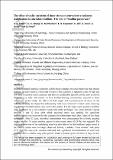Files in this item
The effect of cyclic variation of shear stress on non-cohesive sediment stabilization by microbial biofilms : the role of ‘biofilm precursors’
Item metadata
| dc.contributor.author | Chen, Xindi | |
| dc.contributor.author | Zhang, Changkuan | |
| dc.contributor.author | Paterson, David M. | |
| dc.contributor.author | Townend, Ian H. | |
| dc.contributor.author | Jin, Chuang | |
| dc.contributor.author | Zhou, Zeng | |
| dc.contributor.author | Gong, Zheng | |
| dc.contributor.author | Feng, Qian | |
| dc.date.accessioned | 2020-02-01T00:34:54Z | |
| dc.date.available | 2020-02-01T00:34:54Z | |
| dc.date.issued | 2019-02-01 | |
| dc.identifier | 257337853 | |
| dc.identifier | 885ce7fb-b207-4e52-8add-e6dc46f6aa13 | |
| dc.identifier | 85060926001 | |
| dc.identifier | 000469991600009 | |
| dc.identifier.citation | Chen , X , Zhang , C , Paterson , D M , Townend , I H , Jin , C , Zhou , Z , Gong , Z & Feng , Q 2019 , ' The effect of cyclic variation of shear stress on non-cohesive sediment stabilization by microbial biofilms : the role of ‘biofilm precursors’ ' , Earth Surface Processes and Landforms , vol. Early View . https://doi.org/10.1002/esp.4573 | en |
| dc.identifier.issn | 0197-9337 | |
| dc.identifier.other | RIS: urn:26177A3C0DF8A05B6D46A77A11EB74CB | |
| dc.identifier.other | ORCID: /0000-0003-1174-6476/work/53548928 | |
| dc.identifier.uri | https://hdl.handle.net/10023/19394 | |
| dc.description | This work was supported by the National Natural Science Foundation of China (NSFC, Grant Nos. 51620105005, 51879095, 51579072, 41606104). D. M. Paterson received funding from the MASTS pooling initiative (The Marine Alliance for Science and Technology for Scotland) and the NERC Blue-coast consortium (N E/N016009/1) and their support is gratefully acknowledged. MASTS is funded by the Scottish Funding Council (grant reference HR09011) and contributing institutions. X. D. Chen received funding from the China Scholarship Council. | en |
| dc.description.abstract | Biofilm mediated intertidal sediments exhibit more complex erosional behaviour than abiotic systems. A major feature of intertidal systems is the exposure to repeated cycles of high and low shear created by tidal conditions and also less predictable episodic events, such as storms. There is very little information on how biofilm-forming communities respond to these conditions. In this study, the effects of both single and repeated-cycles of shear on the stability of newly developed bio-sedimentary beds was examined. Cleaned sand, without any potential biostabilization, was used as the control. For the single-cycle scenario, biofilms were incubated on a non-cohesive sandy bed under prolonged low shear periods varying between 5 and 22 days, after which erosional stress was applied. No significant biostabilization was observed for the youngest bio-sedimentary bed (after five days of low shear incubation). After 22 days, microbial communities were characterized by a firmly attached surface biofilm. To cause erosion, greater hydrodynamic stress (0.28 Pa) was required. The erosional behaviour of the underlying sand was also affected in that bedform ripples noted in the control system were no longer observed. Instead, a sudden ‘mass erosion’ took place (0.33 Pa). The one-cycle scenario indicated that significant biostabilization of sand only occurred after a relative long calm period. Under repeated cycles of stress (five days of low stress followed by high stress event and re-incubation, repeated for four cycles = 20 days), frequent cyclic disturbance did not degrade the system stability but enhanced biostabilization. The properties of the sub-surface sediments were also affected where erosion rates were further inhibited. We hypothesize that organic material eroded from the bed acted as a ‘biofilm precursor’ supporting the development of new biofilm growth. A conceptual framework is presented to highlight the dynamics of bio-sedimentary beds and the effects of growth history under repeated-cycles. | |
| dc.format.extent | 11 | |
| dc.format.extent | 1669589 | |
| dc.language.iso | eng | |
| dc.relation.ispartof | Earth Surface Processes and Landforms | en |
| dc.subject | Biostabilisation | en |
| dc.subject | Biofilm detachment | en |
| dc.subject | Sediment erosion | en |
| dc.subject | Biofilm regrowth | en |
| dc.subject | Bio-sedimentary system | en |
| dc.subject | GE Environmental Sciences | en |
| dc.subject | Earth and Planetary Sciences (miscellaneous) | en |
| dc.subject | Earth-Surface Processes | en |
| dc.subject | Geography, Planning and Development | en |
| dc.subject | NDAS | en |
| dc.subject.lcc | GE | en |
| dc.title | The effect of cyclic variation of shear stress on non-cohesive sediment stabilization by microbial biofilms : the role of ‘biofilm precursors’ | en |
| dc.type | Journal article | en |
| dc.contributor.sponsor | NERC | en |
| dc.contributor.institution | University of St Andrews. Sediment Ecology Research Group | en |
| dc.contributor.institution | University of St Andrews. School of Biology | en |
| dc.contributor.institution | University of St Andrews. Marine Alliance for Science & Technology Scotland | en |
| dc.contributor.institution | University of St Andrews. Scottish Oceans Institute | en |
| dc.contributor.institution | University of St Andrews. St Andrews Sustainability Institute | en |
| dc.identifier.doi | 10.1002/esp.4573 | |
| dc.description.status | Peer reviewed | en |
| dc.date.embargoedUntil | 2020-02-01 | |
| dc.identifier.grantnumber | NE/N016009/1 | en |
This item appears in the following Collection(s)
Items in the St Andrews Research Repository are protected by copyright, with all rights reserved, unless otherwise indicated.

